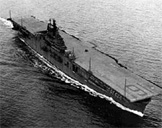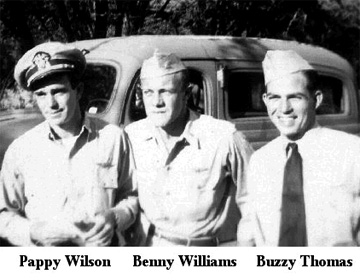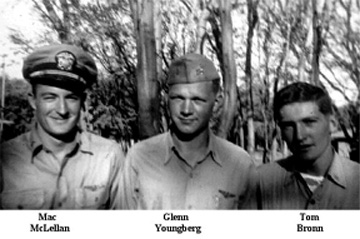 |
Fred Gwynn's Chapter 1 |
|||||
 |
||||||
| All of these boys were also married, which made the consecutively alternating job of Squadron Duty Officer a nightmare; each officer would have it about once a week and have to forsake his wife for a dirty overnight pallet in the cold and noisy hangar. Finally Axel Youngberg, giant and blonde, and Buzzy Thomas, dark and swarthy, turned up, their bachelor status occasioning great joy among the husbands. |
||||||
 |
||||||
| But while the Squadron debated whether to get away with making Axel and Buzzy and John Hull permanent Duty Officers, a new problem threatened the marital and holiday peace. A dispatch slipped in ordering two VT pilots to report to Norfolk immediately for a course in aerial photography. Since Norfolk was obviously a much worse evil than the Squadron Duty, Youngberg and Thomas were appointed Photographic Officers and packed off to a dismal city for a dismal Christmas. Months later they discovered that this invaluable experience enabled them to make extra trips to Japanese islands to shoot pictures.
To Norfolk also went three good radiomen - Averill, Bryan and Frede - to learn about the newfangled radar that was being installed in Grumman torpedo-planes. Two days before Christmas three Grumman Avengers, in many ways the most accomplished military plane ever built, finally reached VT-16. While half the pilots had been flying them at Ft. Lauderdale's paradisal operational training base, the other half had had no experience with the monster. Bowen and Curry got their check-outs in the plane on a stormy Christmas Day, when they were ordered to fly up the New England coast in search of another TBF belonging to Torpedo 4. They never found it, but they learned a lot about the Avenger. It was a tremendous craft (weighing nearly eight tons), the largest possible carrier plane. It packed a torpedo internally, in a bomb-bay that could also hold an enormous load of bombs, depth-charges, smokescreen tank, extra gasoline, or baggage. It had a lot of horsepower in the engine, a .50-caliber turret, and two .30-caliber "morale" guns operated by the pilot forward and the radioman aft, designed to let the enemy know the presence, if not efficiency, of firepower. The TBF made its debut at Midway, when part of Torpedo 8 took six Avengers into battle. Only one came back, but Leroy Grumman flew out to Pearl Harbor and got enough praise to know that he had put out another excellent Navy plane. The TBF could do a lot of damage and could absorb a lot, and she was a handsome and extremely safe craft as well. |
||||||
| Torpedo 16 spent January welcoming new pilots, ferrying new planes to Quonset, and getting to know the Avenger. Shifty Schopmeyer, Ben Williams, Gene Ternasky, Pontoon Swanson, Meat-Axe Thompson, Pappy Wilson, Bob Wolfe, Bob Crader, Mac McLellan, Harry Minarik, and Fearless Fred Warren almost completed the compliment of pilots. |
||||||
 |
||||||
| Two more aviation specialists filled necessary gaps: Travis Oliver, a lawyer from Louisiana, took over the Gunnery Department, and Lewis Polansky manned the radio and radar sets. Polansky was a warrant officer who had come up the hard way as a flying radioman in patrol squadrons, and he had been at Pearl Harbor and Midway during Jap attacks, as well as having had cruiser and battleship duty as a seaman.
Bill Linn and I turned up on February 17, 1943, the day that our carrier, the new U.S.S. Lexington, was commissioned at the Bethlehem Yards in Fore River. Newbold Landon beat us by ten days and Munchkin Delgado came a couple of days later, but the four of us comprised one of the three or four groups of contemporaneous trainees who were plunked into Torpedo 16. After leaving Ft. Lauderdale, we had spent five weeks in Norfolk for the purpose of making eight qualifying carrier landings on the U.S.S. Charger, an operation that took about thirty minutes to run off, but which was blocked by the weather of Chesapeake Bay, the engines of the Charger, and a multitude of pilots waiting to be qualified. Since no one ever tells an ensign anything, we were under the impression that the Lexington might sail without us, so we nearly went crazy trying to get checked out of Norfolk. If you were late to muster down there, your name went to the bottom of the qualifying list. And if we'd known that the Lex would not sail until May and that Torpedo 16 was presently in an eager and cheerless training period, we would have been late to those musters everyday. Especially as Bill Linn met a wonderful girl in Norfolk practically on the last day of our visit. But we finally got to Quonset, and there we stayed for three more desolate months. There were complex reasons for this desolation, some reasonable, some puzzling. In the first place, Quonset Point was a cold, windy, and rainy spot to spend the winter, to the special annoyance of our Southern contingent. The weather not only chilled the marrow but it disrupted the flight schedule, so that all the agonies of abortive flights, dangerous fog and wind, and that occupational disease of ready-room-itis seemed to plague us every other day. End of Page 2 of Chapter 1 — Go to Page 3 Page — 1 — 2 — 3 — 4 — 5 — this chapter you may go to Introduction — Table of Contents Chapter — 1 — 2 — 3 — 4 — Epilogue — or Go to the Lexington Stories Cover Page Or Home - Contact Us - Cold War Hist. - 91st SRS Hist. - Stardust 40 Mission Story |
||||||